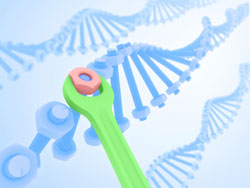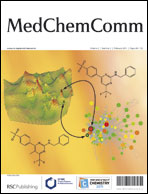This month sees the following articles in MedChemComm that are in the top ten most accessed:-
Silver nanoparticles – the real “silver bullet” in clinical medicine?
Kenneth K. Y. Wong and Xuelai Liu
Med. Chem. Commun., 2010, 1, 125-131, DOI: 10.1039/C0MD00069H, Review
Targeting epigenetic modifiers: Inhibitors of histone methyltransferases
Elisabeth-Maria Bissinger, Ralf Heinke, Wolfgang Sippl and Manfred Jung
Med. Chem. Commun., 2010, 1, 114-124, DOI: 10.1039/C0MD00062K, Review
Discovery of the highly potent PI3K/mTOR dual inhibitor PF-04691502 through structure based drug design
Hengmiao Cheng, Shubha Bagrodia, Simon Bailey, Martin Edwards, Jacqui Hoffman, Qiyue Hu, Robert Kania, Daniel R. Knighton, Matthew A. Marx, Sacha Ninkovic, Shaoxian Sun and Eric Zhang
Med. Chem. Commun., 2010, 1, 139-144 , DOI: 10.1039/C0MD00072H, Concise Article
Boronic acids in medicinal chemistry: anticancer, antibacterial and antiviral applications
Paul C. Trippier and Christopher McGuigan
Med. Chem. Commun., 2010, 1, 183-198, DOI: 10.1039/C0MD00119H, Review
Small molecule modulation of stem cells in regenerative medicine: recent applications and future direction
Timothy E. Allsopp, Mark E. Bunnage and Paul V. Fish
Med. Chem. Commun., 2010, 1, 16-29, DOI: 10.1039/C0MD00055H, Review
Synthesis and biological evaluation of novel ferrocenyl curcuminoid derivatives
Anusch Arezki, Guy G. Chabot, Lionel Quentin, Daniel Scherman, Gérard Jaouen and Emilie Brulé
Med. Chem. Commun., 2011, Advance Article, DOI: 10.1039/C0MD00231C, Concise Article
Chemical space as a source for new drugs
Jean-Louis Reymond, Ruud van Deursen, Lorenz C. Blum and Lars Ruddigkeit
Med. Chem. Commun., 2010, 1, 30-38, DOI: 10.1039/C0MD00020E, Review
Novel indolizine compounds as potent inhibitors of phosphodiesterase IV (PDE4): structure-activity relationship
Shoujun Chen, Zhiqiang Xia, Masazumi Nagai, Rongzhen Lu, Elena Kostik, Teresa Przewloka, Minghu Song, Dinesh Chimmanamada, David James, Shijie Zhang, Jun Jiang, Mitsunori Ono, Keizo Koya and Lijun Sun
Med. Chem. Commun., 2011, Advance Article, DOI: 10.1039/C0MD00215A, Concise Article
Aromatic chloride to nitrile transformation: medicinal and synthetic chemistry
Lyn H. Jones, Nicholas W. Summerhill, Nigel A. Swain and James E. Mills
Med. Chem. Commun., 2010, 1, 309-318, DOI: 10.1039/C0MD00135J, Review
Biofunctional TiO2 nanoparticle-mediated photokilling of cancer cells using UV irradiation
Kazusa Matsui, Miki Karasaki, Maiko Segawa, Sang Youn Hwang, Tsutomu Tanaka, Chiaki Ogino and Akihiko Kondo
Med. Chem. Commun., 2010, 1, 209-211, DOI: 10.1039/C0MD00027B, Concise Article
Why not take a look at the articles today and blog your thoughts and comments below.
Fancy submitting an article to MedChemComm? Then why not submit to us today or alternatively email us your suggestions.














 This new and exciting issue comes with two reviews.
This new and exciting issue comes with two reviews.